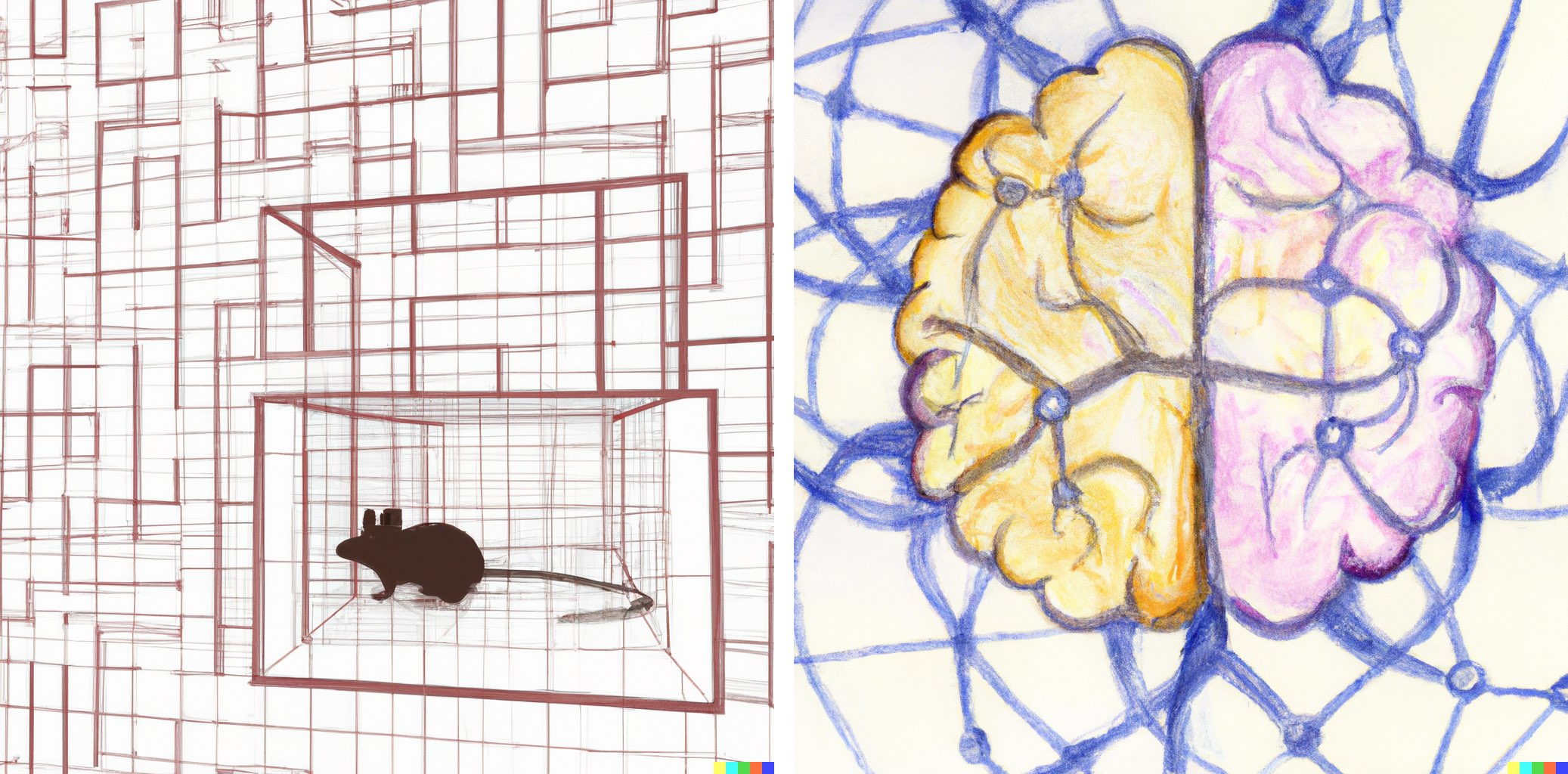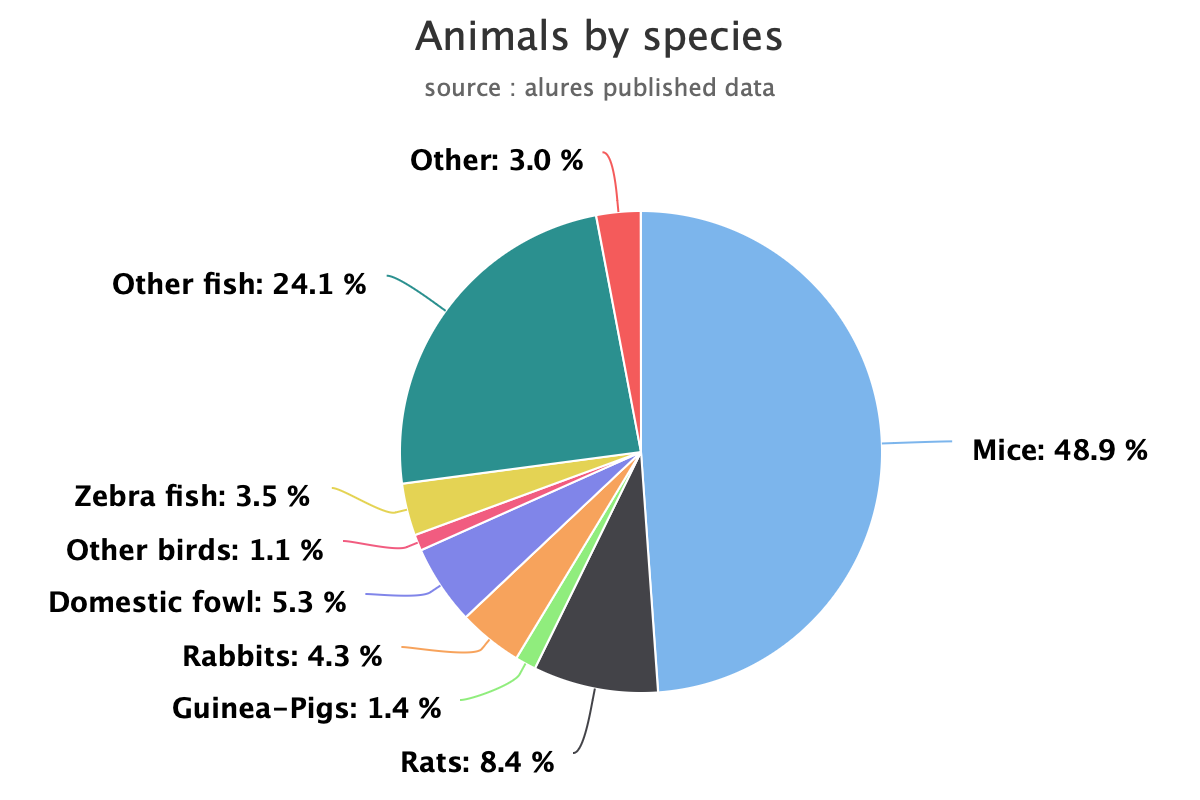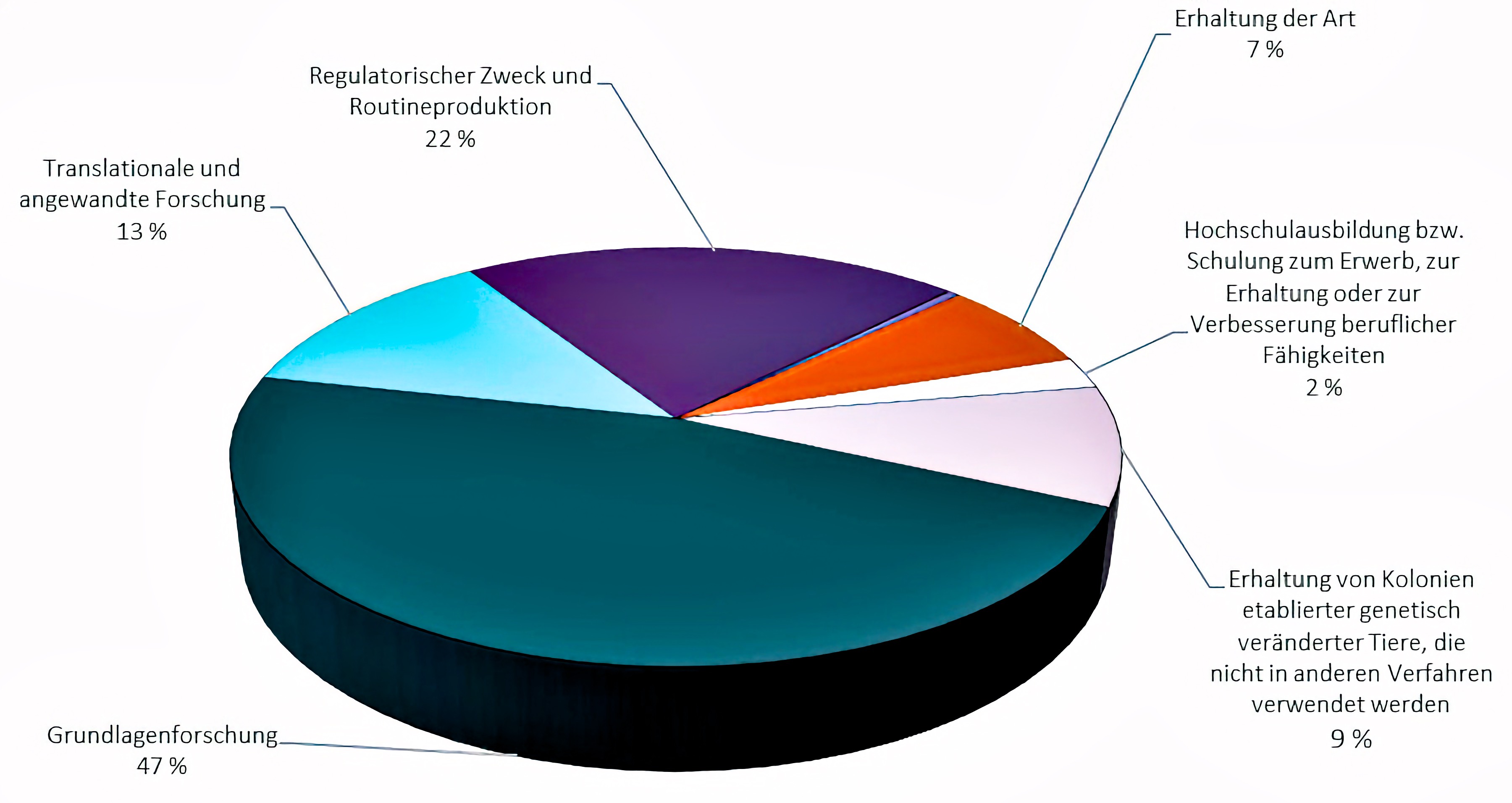Behavioral experiments and animal welfare
In the next four chapters, we will learn about the importance of animal behavior experiments in neuroscience and the ethical guidelines that govern these experiments. In particular, we will learn
- why animal behavior experiments are crucial for understanding the brain (this chapter),
- the importance of the Three Rs principle in animal research (this chapter),
- the relation between state-of-the-art neuroscience research and animal welfare (this chapter),
- what is multi-modal behavior phenotyping and how it can be used to study animal behavior (Chapter 2),
- what are high-throughput behavioral experiments (Chapter 2),
- how to assess animal behavior with machine learning (Chapter 3), and
- how to decipher animal behavior and neuronal activity in latent space (Chapter 4).
We conclude this lecture with a hands-on behavioral data analysis tutorial of our choice.
Why perform animal behavior experiments?
The study of animal behavior, or ethologyꜛ, has always been a pivotal part of neuroscience, offering insights into neurological functioning that are crucial to understanding both normal and pathological processes.
 Animal behavior experiments help to understand the intricate relationship between brain functions and the associated behavior. Images generated with DALL-E (source for the leftꜛ and right imageꜛ)
Animal behavior experiments help to understand the intricate relationship between brain functions and the associated behavior. Images generated with DALL-E (source for the leftꜛ and right imageꜛ)
Behavioral experiments help to understand the intricate relationship between neurobiology and behavior, essentially deciphering how brain functions translate into observable actions. This understanding is crucial as it helps illuminate the neural circuits and mechanisms underlying various behaviors, ranging from basic locomotor activities to complex cognitive tasks like learning, memory, and social interaction.
By utilizing animal models, we are able to probe these relationships in detail and under controlled conditions. Techniques like optogenetics and in vivo two-photon imaging have been instrumental in this endeavor, revealing how specific neurons, circuits, and neuronal populations encode, process information, and drive behavior (Deisseroth, 2011ꜛ; Svoboda & Yasuda, 2006ꜛ). This research not only propels our fundamental understanding of the brain but also aids in developing novel treatments for neurological and psychiatric disorders, which often manifest as aberrant behaviors stemming from dysfunctions in neural circuitry.
Animal welfare and three Rs principle
Traditionally, this field has heavily relied, but not only, on rodent models, especially mice, due to their genetic tractability, relatively short life span, and the existence of a rich repertoire of well-characterized behaviors. Other species, such as zebrafish and fruit flies, are also commonly used in behavioral neuroscience research.
 Abstract representation of a mouse in a behavioral maze task (left) a zebrafish in a water basing (middle), and a fruit fly “under” investigation (right). Images generated with DALL-E (source for the leftꜛ, middleꜛ, and right imageꜛ)
Abstract representation of a mouse in a behavioral maze task (left) a zebrafish in a water basing (middle), and a fruit fly “under” investigation (right). Images generated with DALL-E (source for the leftꜛ, middleꜛ, and right imageꜛ)
While conducting animal experiments, it is crucial to respect the ethical guidelines summarized in the “Three Rs” principle. This includes:
- Replacement, which aims to substitute sentient animals with non-sentient alternatives or in vitro methods (or computational modeling) whenever possible;
- Reduction, where the goal is to minimize the number of animals used in an experiment by leveraging advanced statistical models, advanced computational techniques, and experimental designs; and
- Refinement, which involves minimizing the suffering of animal subjects through improvements in care conditions and the humane termination of experiments when necessary.
Animal experiments are strictly regulated within the European Union (EU), with national laws further reinforcing these guidelines. In Germany, the Federal Ministry of Food and Agriculture (Bundesministerium für Ernährung und Landwirtschaft, BMEL) is the administrative organization responsible for overseeing animal welfare, including in scientific research. Furthermore, professional organizations like the Gesellschaft für Versuchstierkunde - Society for Laboratory Animal Science (GV-SOLAS)ꜛ play a significant role in promoting animal welfare. GV-SOLAS encourages research into alternatives to animal use, advocates for improvements in animal housing and care, promotes training for those working with laboratory animals, and provides a platform for information exchange in the field of laboratory animal science.
 In the EU, there are high standards for animal welfare in research. Image generated with DALL-E (sourceꜛ)
In the EU, there are high standards for animal welfare in research. Image generated with DALL-E (sourceꜛ)
The EU directive 2010/63/EUꜛ on the protection of animals used for scientific purposes and national regulations provide several key stipulations to ensure high standards of animal treatment. These guidelines include the mandatory application of the Three Rs principle in all stages of research involving animals. Before any experimental procedure can be conducted, it must be evaluated by an ethics committee. Individuals conducting animal experiments must be appropriately trained and qualified. Standards for the welfare and treatment of the animals, including housing, care, and the method of euthanasia, are also rigorously regulated to minimize stress and ensure humane treatment.
What animal experiments mean in numbers:
| Species | used in research 2018 | used in in research 2019 |
|---|---|---|
| mice | 1.539.575 | 1.438.336 |
| rats | 222.811 | 196.973 |
| rabbits | 85.193 | 94.240 |
| birds | 30.393 | 35.718 |
| fish | 192.040 | 347.543 |
Animal species used in animal experiments in Germany pursuant to § 7 (2) of the Animal Welfare Act in 2018 and 2019. Source: bmel.deꜛ. Also see: understandinganimalresearch.org: EU wide animal research statistics, 2020 for more information on animal research in the EU.
For comparison, the number of animals killed in the food industry in Germany in 2022:
| Species | killed in 2022 |
|---|---|
| chickens from the fattening | 631 million |
| pigs | 47 million |
| turkeys | 31 million |
| hens from the egg industry | 30 million |
| other animals (e.g. cattle, sheep, geese, ducks) | 14 million |
Animal species killed in the food industry in Germany in 2022 (figures are rounded). Source: destatis.de 41322-0002ꜛ, 41331-0001ꜛ, 41331-0004ꜛ
Overview of animal species used for research:
 Numbers of animals used for research in the EU and Norway in 2020. Source: ALURES – ANIMAL USE REPORTING - EU SYSTEMꜛ
Numbers of animals used for research in the EU and Norway in 2020. Source: ALURES – ANIMAL USE REPORTING - EU SYSTEMꜛ
Scientific purposes:
 Scientific experimental purposes in 2019 in Germany. Source: bmel.deꜛ
Scientific experimental purposes in 2019 in Germany. Source: bmel.deꜛ
State-of-the-art behavioral experiments and their role in adhering to the Three Rs principle
The field of neuroscience is experiencing significant advancements, notably in the adoption of high-precision techniques and high-throughput experiments, which play a crucial role in adhering to the Three Rs principle. These contemporary methods have revolutionized researchers’ capacity to manipulate and observe neuronal activity with unparalleled accuracy and specificity.
For example, state-of-the-art techniques like optogeneticsꜛ provide the ability to accurately target and control specific neural circuits, and cutting-edge imaging modalities such as two-photon microscopyꜛ enable real-time observation of neuronal activity. These approaches not only refine the precision of the experimental process but also align with the Three Rs principle, mainly by refining the experimental procedures to minimize animal discomfort.
Simultaneously, there is a shift ongoing towards high-throughput and multi-modal behavioral experiments, where multiple animals can be observed with multiple and high-precision sensors at once. This strategy serves dual purposes: it enables the observation of more naturalistic social behaviors akin to wild conditions and significantly increases the volume of data collectable simultaneously, thereby enhancing the statistical power of findings and aligning with the reduction principle of the Three Rs.
The integration of machine learning into data analysis parallels these developments. The capacity of machine learning to discern patterns and correlations within large, complex datasets facilitates the discovery of nuanced links between behavior and neuronal activity. This progress not only deepens our understanding of complex processes underpinning cognition and behavior but also aligns with the reduction and refinement principles by improving the efficiency and precision of data analysis.
In conclusion, modern neuroscience leverages state-of-the-art techniques, high-throughput experiments, and sophisticated machine learning analytics, standing at the forefront of our evolving understanding of the nervous system’s influence on behavior. These advances hold immense promise for the future, underlining the potential for these cutting-edge methodologies to further adhere to the Three Rs principle, while fostering an interdisciplinary synergy between neuroscience, computer science, and related fields.
Further readings
- Jerry J. Buccafusco (2008), Methods of Behavior Analysis in Neuroscience, CRC Press/Taylor & Francis, freely available on https://www.ncbi.nlm.nih.gov/books/NBK5228/ꜛ
- Garrett, Bob, (2017), Brain & Behavior: An introduction to behavioral neuroscience, SAGE PUBNS, INC, ISBN: 978-1-5443-1750-2.
- Svoboda, K., & Yasuda, R. (2006). Principles of two-photon excitation microscopy and its applications to neuroscience. Neuron, 50(6), 823-839, 10.1016/j.neuron.2006.05.019ꜛ. A key paper on two-photon microscopy, an important technique for imaging neurons in living organisms.
- Wikipedia article on Two-photon excitation microscopyꜛ
- Deisseroth, K. (2011). Optogenetics. Nature Methods, 8(1), 26–29. doi.org/10.1038/nmeth.f.324ꜛ. This paper discusses optogenetics, a key technique in neuroscience that allows precise manipulation of neurons.
- Wikipedia article on Optogeneticsꜛ
- Gomez-Marin, A., Paton, J. J., Kampff, A. R., Costa, R. M., & Mainen, Z. F. (2014). Big behavioral data: psychology, ethology and the foundations of neuroscience. Nature Neuroscience, 17(11), 1455-1462, doi.org/10.1038/nn.3812ꜛ. This paper discusses the use of large-scale, high-throughput experiments in the study of behavior.
- Jordan, M. I., & Mitchell, T. M. (2015). Machine learning: Trends, perspectives, and prospects. Science, 349(6245), 255-260, doi.org/10.1126/science.aaa8415ꜛ. This review discusses the general principles of machine learning and its various applications, including in neuroscience.
- Animals in science. EU actions for the protection of animals used for scientific purposesꜛ
- EU wide animal research statistics, 2020ꜛ
- Verwendung von Versuchstieren im Jahr 2019ꜛ
- destatis.de 41322-0002ꜛ, 41331-0001ꜛ, 41331-0004ꜛ
- ALURES – ANIMAL USE REPORTING - EU SYSTEM ꜛ
- understandinganimalresearch.org: EU wide animal research statistics, 2020
- EU directive 2010/63/EUꜛ
- GV-SOLASꜛ
- Festing, S., & Wilkinson, R. (2007). The ethics of animal research. Talking Point on the use of animals in scientific research. EMBO reports, 8(6), 526-530. doi:10.1038/sj.embor.7400993ꜛ
